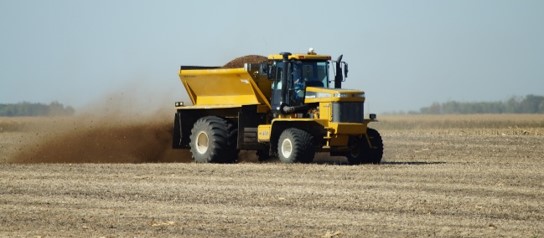Importance of Potassium
Potassium (K) is one of three macronutrients that all plants require for growth. Potassium is needed to move sugars and other forms of energy throughout the plant, allow gas exchange with the atmosphere through the stomata, and aid in cell wall strength. In dry conditions, potassium helps the plant stay rigid and upright. Adequate potassium fertility is essential to maximizing crop yields.
Forms of Potassium Fertilizers
Analyses of potassium fertilizers are typically reported as percent K2O (potassium oxide), a potassium form that is not actually present in fertilizers but is used as an industry standard measure. In a standard fertilizer analysis, the third number is the percent of K2O by weight in the fertilizer. To convert amounts of K2O to K+, use the following equations:
- lbs K+ = 0.8 x lbs K2O
- lbs K2O = 1.2 x lbs K+
KCl – Muriate of Potash (0-0-60)
- Most common form of potassium fertilizer, soluble in water.
- Will cause injury if placed to close to the seed
K2SO4 – Sulfate of Potash (0-0-50)
- Three times less soluble than KCl
- Provides sulfur as well as potassium to the plant
K2SO4 MgSO4 – Sulfate of Potash-Magnesia (0-0-22)
- Soluble in the soil when the soil is moist
- Less than 3% chloride, less likely to burn seedlings
- Provides sulfur, potassium, and magnesium to the plant
KNO3 – Potassium Nitrate (13-0-44)
- Soluble form of potassium and nitrogen
KOH – Potassium Hydroxide (0-0-70)
- Provides the same availability as KCl
- Used in solution fertilizers
Manure
- Potassium levels in manure differ between animal species. Sheep and poultry have the highest amount of potassium in manure compared to other livestock.
- Animal diet will affect the amount of potassium in the manure. If the grain the animal is digesting has high amounts of potassium, the manure will as well.
- Potassium is most abundant in the liquid portion of manure due to the solubility of the nutrient. Dry manure will not have as much potassium.

Application of Potassium
Biennial potassium applications can be equally as effective as annual applications, as long as the biennial application rate accounts for the nutrient needs of two crops.
Spring application is just as beneficial as applying in the fall, unless soil test levels are in the very low range. Soils with a low CEC may benefit from K application closer to planting to reduce the amount of fertilizer leached.
When starter N+K2O fertilizer is used, do not apply more than 80 lbs/acre to prevent salt injury. If more K2O is needed, broadcast and incorporate before planting.
Nutrient removal due to silage harvest or stover removal should be considered when determining fertilizer rate recommendations, as both will remove more potassium than grain harvest alone. Delaying harvest and removal can reduce nutrient removal rates.
Method of Application
Banding
- Specific cases where banded and starter K applications may be beneficial include:
- Heavy or wet soils that are slow to warm in the spring
- Soils that are high testing for K, on average, but are characterized by a high degree of soil test variability
- No-till, strip-till, and zone-till, for which K is typically banded at planting
- Use only half of the broadcast recommended rate when banding. This will not limit yield.
Broadcast
- This is the recommended application method for soybeans when the fertilizer is applied in the spring.
- Incorporation is recommended.
Author: Samantha Reicks






